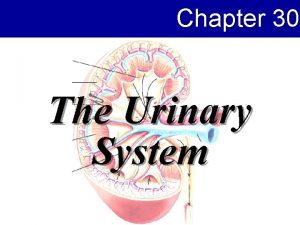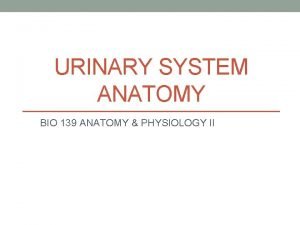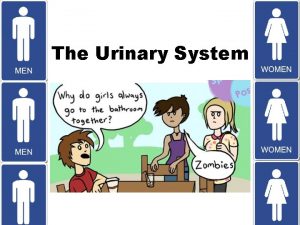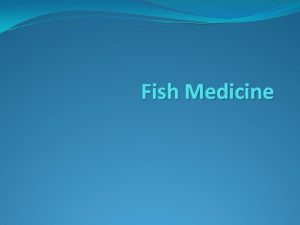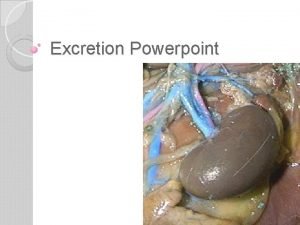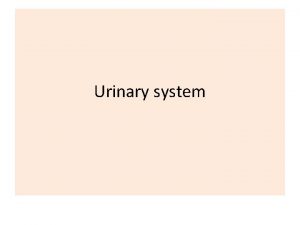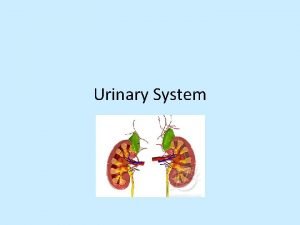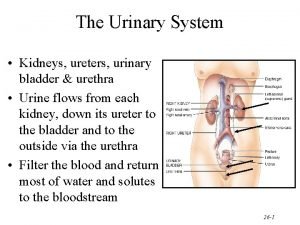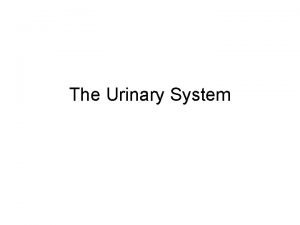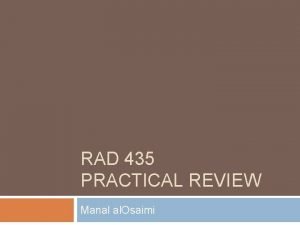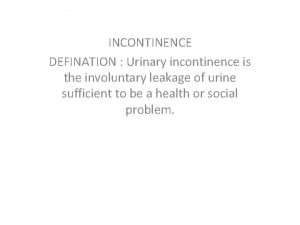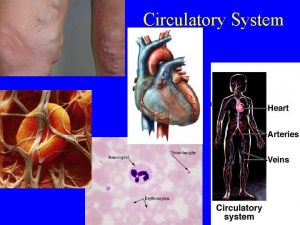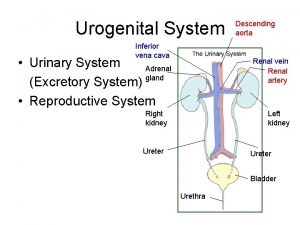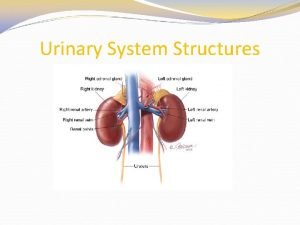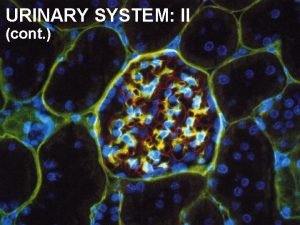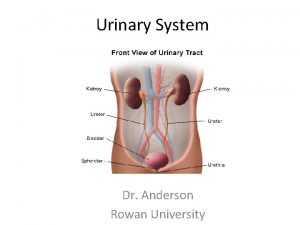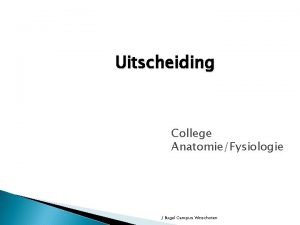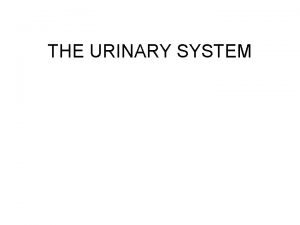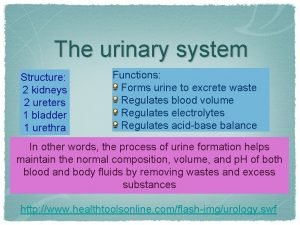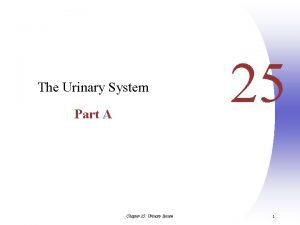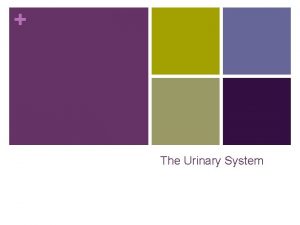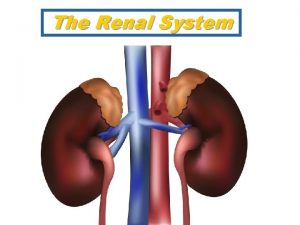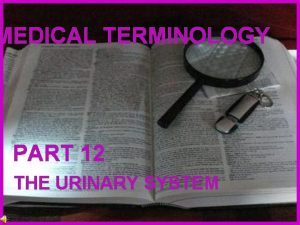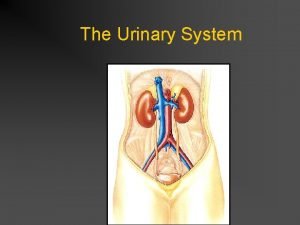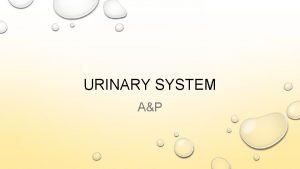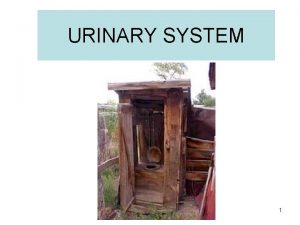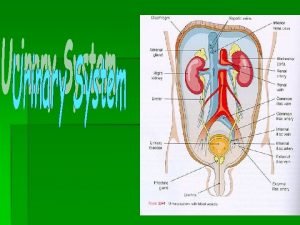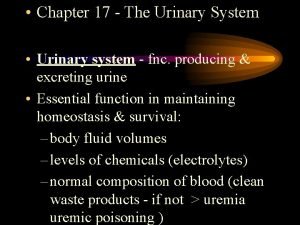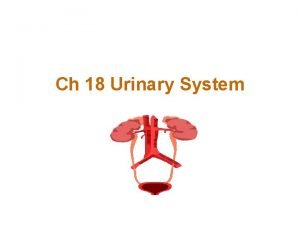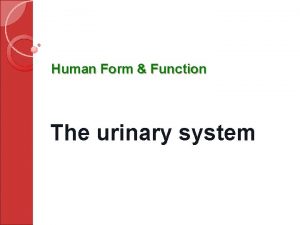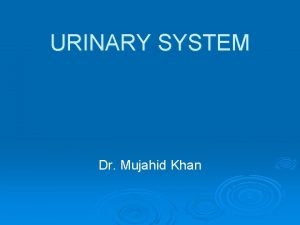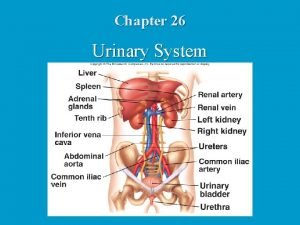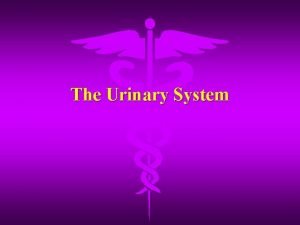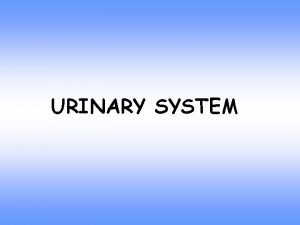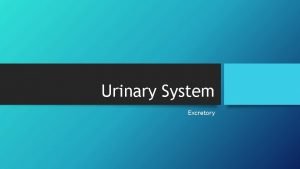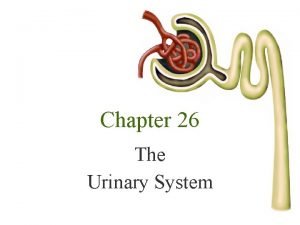Learning Outcome C 13 URINARY SYSTEM LEARNING OUTCOME




































- Slides: 36

Learning Outcome C 13 URINARY SYSTEM

LEARNING OUTCOME C 13 � Analyse the functional interrelationships of the structures of the urinary system

STUDENT ACHIEVEMENT INDICATORS Students who have fully met this learning outcome are able to: Identify and explain the functions of each of the following: kidney ureter urethra urinary bladder renal cortex renal medulla renal pelvis nephron Identify and explain the functions of the following components of the nephron: glomerulus Bowman’s capsule afferent and efferent arterioles peritubular capillary network proximal and distal convoluted tubules collecting duct Loop of Henle

STUDENT ACHIEVEMENT INDICATORS Describe the production of urine with reference to the following terms: pressure filtration selective reabsorption of water following an osmotic gradient tubular excretion metabolic waste Describe how the kidneys maintain blood p. H Compare urea and glucose content of blood in the renal artery with that of the renal vein Identify the source glands for antidiuretic hormone (ADH) and aldosterone Describe how the hypothalamus, posterior pituitary, ADH, and the nephron achieve homeostasis of water levels in the blood Describe how the adrenal cortex, aldosterone, and the nephron achieve homeostasis of water and sodium levels in the blood

URINARY SYSTEM & EXCRETION The kidneys are the primary organ of excretions Excretion is the removal of metabolic wastes from the body

FUNCTIONS OF THE URINARY SYSTEM Excretion of metabolic wastes The kidneys excrete metabolic wastes, notably nitrogenous wastes from amino acids. Urea is the primary nitrogenous end product in metabolism Humans also excrete ammonium, creatine and uric acid. Urea is the by-product of amino acid metabolism The breakdown of amino acids in the liver releases ammonia, which the liver readily combines with carbon dioxide to produce urea. Ammonia is very toxic to cells, but urea is much less toxic. Creatine Phosphate – is a high-energy phosphate reserve molecule in muscles. The breakdown of creatine phosphate results in creatine


FUNCTIONS OF THE URINARY SYSTEM The breakdown of nucleotides containing adenine and thymine produces uric acid. Uric acid is insoluble If too much uric acids is present in the blood crystals form and precipitate out. Crystals of uric acid sometimes collect in joints resulting in gout.



FUNCTIONS OF THE URINARY SYSTEM Maintenance of Water-Salt Balance Blood volume is related to salt imbalance. Salts have the ability to cause osmosis which is the movement of water into and out of the blood. The more salts in the blood the greater the blood volume, the greater the blood pressure Salts also maintain appropriate levels of other ions such as K+, HCO 3 - and Ca 2+ in blood.

FUNCTIONS OF THE URINARY SYSTEM Maintenance of Acid-Base Balance Blood p. H = approx. 7. 4 Kidneys monitor and regulate this p. H by excreting H+ and reabsorbing HCO 3 -. Urine has a p. H of 6 or lower because our diet contains acidic food.

FUNCTIONS OF THE URINARY SYSTEM Secretion of Hormones Assist the endocrine system The kidneys release renin, which leads to the secretion of aldosterone from the adrenal cortex The adrenal cortex is the outer portion of the adrenal gland which lies on the kidney. Aldosterone promotes the absorption of Na+ by the kidneys. Kidneys secret the hormone erythropoietin which stimulates RBC production and maturation.



ORGANS OF THE URINARY SYSTEM Kidneys are paired organs Located near the small of the back in the lumbar region on either sides of the vertebral column. Bean shaped Reddish brown color Covered by a tough capsule of fibrous connective tissue called the renal capsule. Masses of adipose (fat) tissue s are attached to each kidney. The concave side of the kidney has depression called the ilium where a renal artery enters a renal veins and ureter exits.



ORGANS OF THE URINARY SYSTEM Ureters Conduct urine form the kidneys to the bladder Small muscular tubes The walls of ureters have three layers: Inner mucosa (mucous membrane) Smooth muscle layer Outer fibrous coat of connective tissue Peristaltic contractions cause urine to enter the bladder, even if the person is lying done. Urine enters the bladder in spurts at the rate of 1 -5 per minute.


ORGANS OF THE URINARY SYSTEM Urinary Bladder Stores urine until it is expelled Located in the pelvic cavity 3 openings: 2 for ureters 1 for urinary bladder Bladder is expandable. Small folds of bladder mucosa act like valves to prevent the backflow of urine to ureters from the urinary bladder.

ORGANS OF THE URINARY SYSTEM Two sphincters are located near where the urethra exits the bladder to help control urination: Internal sphincter – opening around urethra External sphincter Composed of skeletal muscle that can be voluntarily controlled Incontinence – involuntary loss of urine Related to changes in urinary bladder and nervous system diseases. Usually affects elderly and pregnant women.

ORGANS OF THE URINARY SYSTEM Urethra Small tube carries urine form the bladder to an external opening Females - 4 cm Males - 20 cm In males connected to reproductive functions Carries urine and semen As the urethra leave the urinary bladder it is encircle by the prostate In men over 40 the prostate gland may become enlarged and this may restrict urination.

URINATION When the urinary bladder fills to about 250 m. L with urine, stretch receptors send an impulse to the nerve cord. The motor nerve impulses causes the urinary bladder to contract and the sphincters to relax so urination can occur. In toddlers, children and adults the brain control this reflex, delaying urination to a suitable time.

ANATOMY OF THE KIDNEY & EXCRETION The kidney has three regions: 1. renal cortex 2. renal medulla 3. Is the outer granulated layer that dips down in between a radially striated inner layer called the renal medulla Consists of cone-shaped tissue masses called renal pyramids renal pelvis Is a central space or cavity that is continuous with the ureters.


ANATOMY OF A NEPHRON Each kidney is compose of over 1 million nephrons (aka renal or kidney tubules). Each nephron has its own blood supply including two capillary regions. Renal artery renal arterioles = glomerulus/capillary within glomerular capsule Blood leaving glomerulus efferent arteriole peritubular capillary network venules renal veins




PARTS OF A NEPHRON Cup-like structure: glomerular capusule (aka Bowmans’ capsule)



PARTS OF A NEPHRON Connects to proximal convoluted tubule Composed of cuboidal epithelial cells and tightly packed microvilli form a brush border to increase surface area for reabsorption. Narrow tube takes a U-turn and becomes the Loop of Henle which is lined with simple squamous epithelial cells. The Loop of Henle becomes the distal convoluted tubule which is composed of cuboidal epithelial cells that have many mitochondria but do not have microvilli. PCT not specialize for reabsorption. DCT of several nephron enter one collecting duct. Many collecting ducts carry urine to the renal pelvis.

URINE FORMATION 1. Glomerular Filtration Occurs when blood enters the afferent arteriole and the glomerulus (capillary) Due to the glomerular blood pressure, water and small molecules move from the glomerulus to the inside of the Bowman’s Capsule This is a filtration process because large molecules are formed and elements are not able to pass through the capillary wall. The glomerular filtrate contains small dissolved molecules in approximately the same concentration as plasma. Any molecule that escapes being filtered as well as the non -filterable components leave the glomerulus via the efferent arteriole.

URINE FORMATION 2. Tubular Reabsorption Occurs when ions are being reabsorbed from the nephron into the blood from the peritubular capillary network. The osmolarity of blood is maintained by the presence of plasma proteins and salt. When Na+ are actively reabsorbed Cl- flows passively The reabsorption of Na. Cl increases the osmolarity of blood compared to filtrate so water moves from the tubule to the blood. Nutrients such as glucose and amino acids also return to the blood at the PCT. This is a selective process because only molecules recognized by carrier proteins can be transported
 Chapter 9 the urinary system labeling exercises
Chapter 9 the urinary system labeling exercises Lymphatic system
Lymphatic system Physiology of urine formation
Physiology of urine formation Kidneys location and structure figure 15-1
Kidneys location and structure figure 15-1 Urethr/o medical terminology
Urethr/o medical terminology Interesting facts about the integumentary system
Interesting facts about the integumentary system Fetal pig masseter muscle
Fetal pig masseter muscle Chapter 30 the urinary system
Chapter 30 the urinary system Kidney pyramid labeled
Kidney pyramid labeled Chapter 20 urinary/excretory system
Chapter 20 urinary/excretory system Urinary system model
Urinary system model Urinary system model
Urinary system model Osteichthyes
Osteichthyes Urinary system powerpoint
Urinary system powerpoint Proximal convoluted tubule histology
Proximal convoluted tubule histology Urinary system pathway
Urinary system pathway Renal corpuscle
Renal corpuscle Figure 15-3 is a diagram of the nephron
Figure 15-3 is a diagram of the nephron Prone
Prone Defination of urine
Defination of urine Excretory system
Excretory system External anatomy of rat
External anatomy of rat Rat urinary system
Rat urinary system Vena cava urinary system
Vena cava urinary system Figure 15-3 is a diagram of the nephron
Figure 15-3 is a diagram of the nephron Dct
Dct Does the urinary system regulate blood pressure
Does the urinary system regulate blood pressure Urinary system
Urinary system Juxtaglomerular apparatus
Juxtaglomerular apparatus What is this called
What is this called Normal and abnormal constituents of urine
Normal and abnormal constituents of urine Urinary system
Urinary system Kidney organ system
Kidney organ system Lith medical term
Lith medical term Uti symptoms
Uti symptoms Arneriole
Arneriole Youtube urinary system
Youtube urinary system







